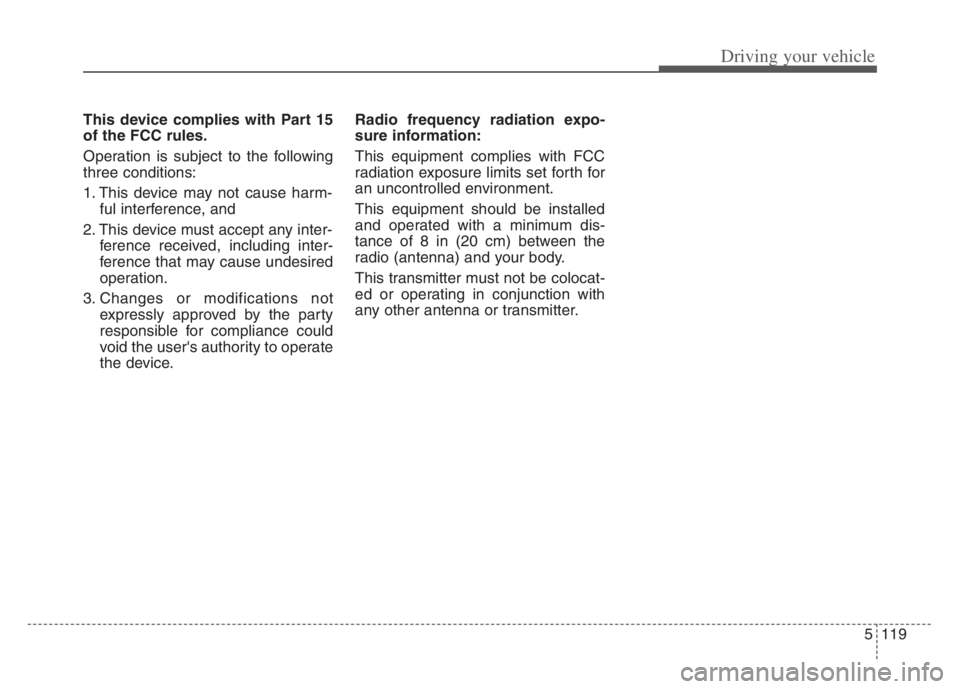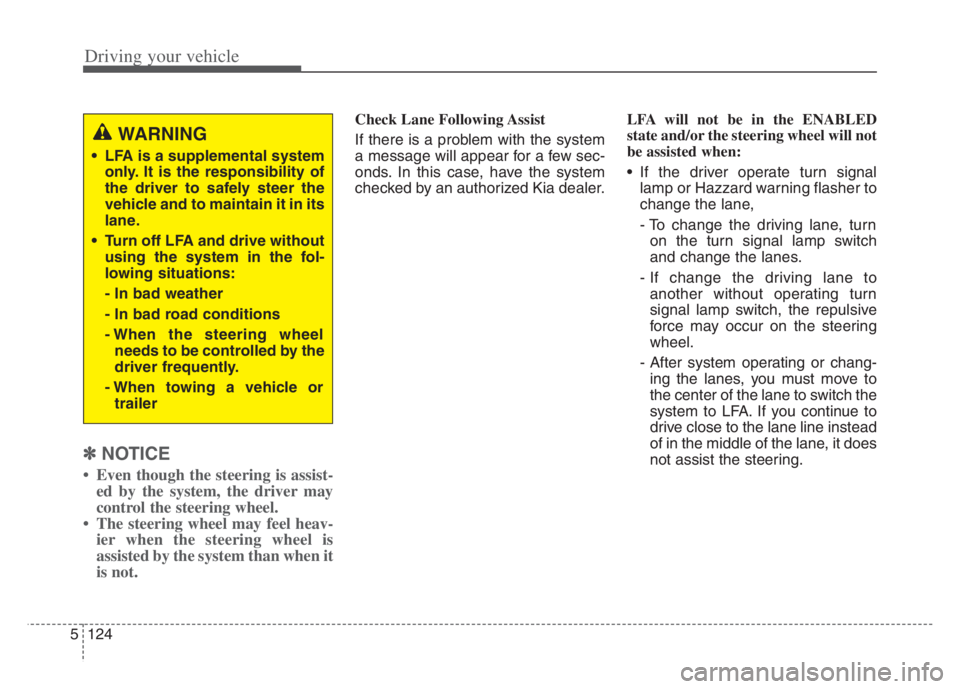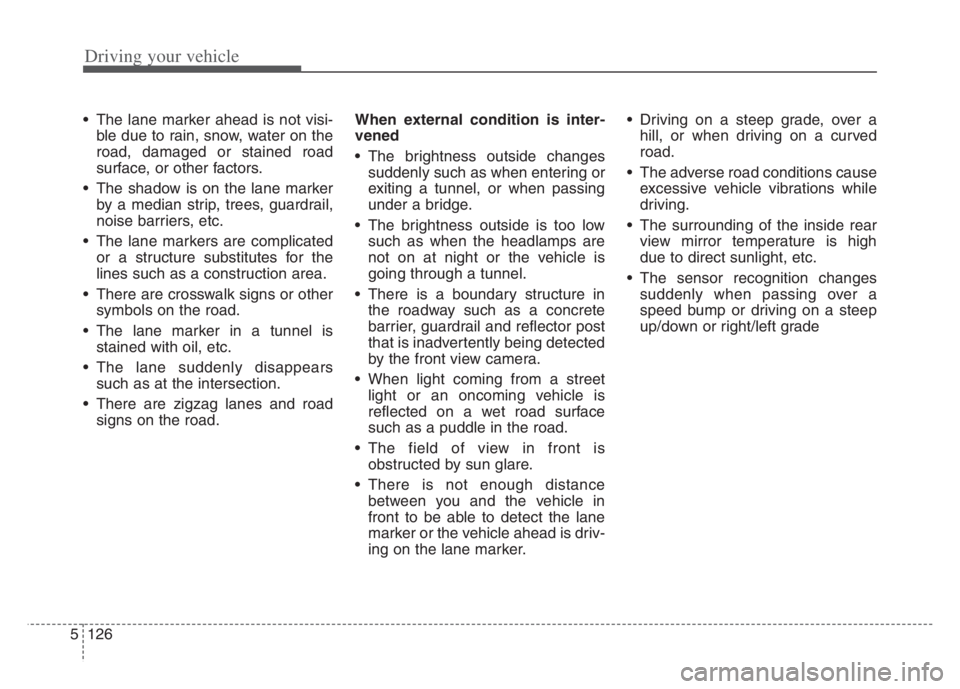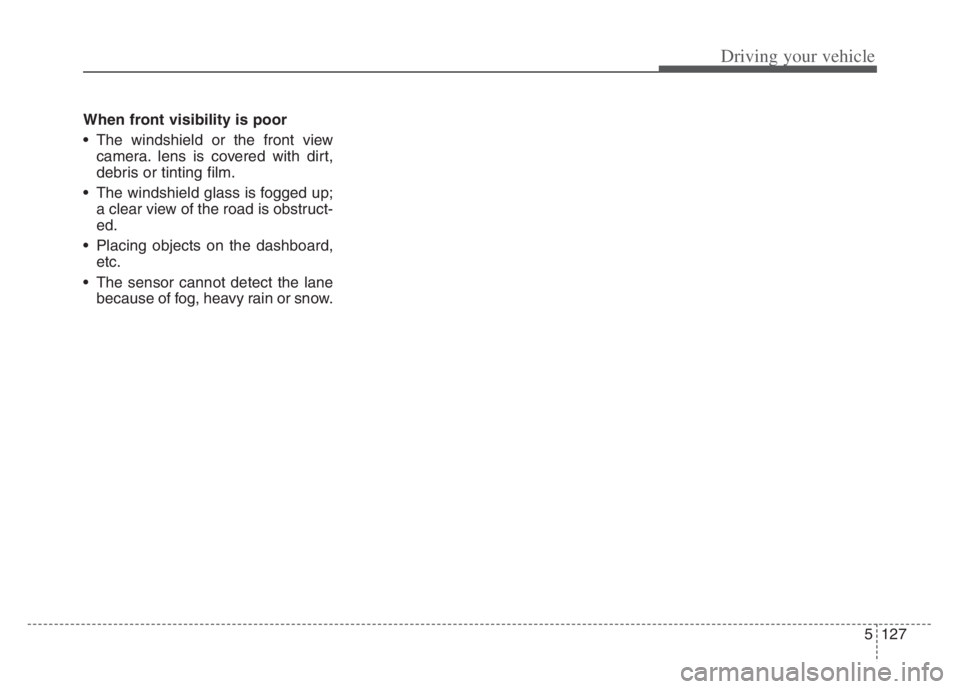KIA CADENZA 2020 Owners Manual
Manufacturer: KIA, Model Year: 2020, Model line: CADENZA, Model: KIA CADENZA 2020Pages: 560, PDF Size: 11.37 MB
Page 371 of 560

Driving your vehicle
118 5
(Continued)
• Deceleration by the system may
not be sufficient if the driver accel-
erates while the system is operat-
ing,
• Deceleration by the system may
not be sufficient due to road con-
ditions such as uneven road sur-
faces, narrow lanes, etc.
• If the road is controlled, due to
construction or holiday events, the
system might not work properly. ✽ ✽
NOTICE
Navigation-based Cruise Control
may not function properly in the fol-
lowing situations :
• The navigation is not working
properly.
• The navigation is not updated.
• The real-time GPS or map infor-
mation provided has errors.
• The navigation is overloaded by
performing functions such as
route search, video playback,
voice recognition, etc. are per-
forming simultaneously.
• GPS signals are blocked in areas
such as a tunnel.
• The driver goes off course or the
route to the destination is changed
or canceled by resetting the navi-
gation.
• The vehicle enters a service station
or rest area.
• A section of the highway’s shape
has changed.
• Android Auto or Car Play is oper-
ating.
(Continued)(Continued)
• The navigation cannot detect the
current vehicle position (ex: ele-
vated roads including overpass
adjacent to general roads or near-
by roads exist in a parallel way).
• The navigation is being updated
while driving.
• The navigation is being reset while
driving.
• The road is slippery due to bad
weather such as rain or snow.
Page 372 of 560

5119
Driving your vehicle
This device complies with Part 15
of the FCC rules.
Operation is subject to the following
three conditions:
1. This device may not cause harm-
ful interference, and
2. This device must accept any inter-
ference received, including inter-
ference that may cause undesired
operation.
3. Changes or modifications not
expressly approved by the party
responsible for compliance could
void the user's authority to operate
the device.Radio frequency radiation expo-
sure information:
This equipment complies with FCC
radiation exposure limits set forth for
an uncontrolled environment.
This equipment should be installed
and operated with a minimum dis-
tance of 8 in (20 cm) between the
radio (antenna) and your body.
This transmitter must not be colocat-
ed or operating in conjunction with
any other antenna or transmitter.
Page 373 of 560

Driving your vehicle
120 5
Lane Following Assist is designed to
center the vehicle in the chosen lane
by using a front mounted camera on
top of the windshield.
It can only become active in combi-
nation with Smart Cruise Control
and therefore assists the driver in his
task to control the lateral movement
of the vehicle.
✽ ✽
NOTICE
• Do not attach glass tinting, stick-
ers, accessories to the windshield
where the front view camera near
the indoor mirror is placed.
• The removal or re-assembly of the
front view camera to attach tint-
ing, stickers, accessories may
require LFA to be thoroughly
inspected and modified. In such
case, have your vehicle inspected
by an authorized Kia dealer.
• Inspection or modification may be
required when replacing parts
related to the windshield or front
view camera, steering. we recom-
mend that the system be checked
by an authorized Kia dealer.
LANE FOLLOWING ASSIST (LFA)
OYG059052
WARNING
It is the driver's responsibility
to operate the steering wheel
for safe driving.
Do not turn the steering wheel
hastily if LFA is operating.
LFA assists the steering
wheel control so that the vehi-
cle can stay in the center of
the lane. LFA does not auto-
matically control the steering
wheel at all times, which
means the driver must keep
hands on the wheel at all
times while driving.
When using LFA, always be
aware of surroundings and
road conditions that may
interrupt or stop LFA.
Page 374 of 560

5121
Driving your vehicle
LFA operation
With the ENGINE START/STOP but-
ton is
in the ON or START position, the
Lane Following Assist can be activat-
ed by pressing the button.
(Continued)
Keeping your hands off the
wheel while driving will trigger
the hands-off warning and
deactivate the steering-assist
system. Put your hands back
on the wheel, then the steer-
ing-assist system will be re-
activated.
When driving at a high speed,
the steering assist force can
become weak and the vehicle
can drive out of its lane. Extra
caution is required, and com-
ply with the speed limit.
Attaching an object to the
steering wheel could deter
steering assistance.
Attaching an object to the
steering wheel could deter the
hands-off alarming system.
OYG059312
CAUTION
Depending on your surround-
ings and road conditions, LFA
could fail to recognize the
lane and stop working. In turn,
extra caution is required
while driving with LFA on.
Be sure to check the non-
operating conditions and cau-
tions for the driver before
using LFA.
Do not place reflective materi-
als such as white paper or
mirror on the crash pad.
Sunlight reflections can cause
a malfunction in LFA.
Too big sound from the sound
system can interrupt the
alarming sound from LFA.
(Continued)
Page 375 of 560

Driving your vehicle
122 5
Operating conditions
When the system is activated, the
indicator ( ) on the cluster will illu-
minate.
While LFA is activated, if press the
button again, the system is
released and indicator ( ) light will
go off.
The color of the indicator will change
depending on the condition of LFA.
- Green : Steering assist mode is
ON
- White :Steering assist mode is
OFF
LFA activation
After LFA is activated, if the vehicle
is within the lane and both lane
markers are detected (lane color
changes grey to white) and there is
no abrupt steering by the driver,
indicator light will change from
white to green. This indicates that
the LFA is in the ENABLED state
and the steering wheel will be able
to be controlled.
The indicator light changes from
green to white when the control is
temporarily cancelled.
When the system does not recog-
nize the lane or depending on the
vehicle condition in front (presence
of the vehicle, driving status, etc.).
the steering wheel is controlled
restrictively.
When the control of the steering
wheel is stopped temporarily the
activation indicator blinks in green
and then changes to white.WARNING
LFA ensures the vehicle stays
in its lane. LFA does not guar-
antee 100% safety. Make sure
you make decisions on the road
after checking the road condi-
tions and safety matters while
driving. Never completely rely
on your LFA.
Page 376 of 560

5123
Driving your vehicle
Warning message
Keep hands on steering wheel
If the driver takes their hands off the
steering wheel for several seconds
while LFA is activated, the system
will warn the driver.
✽ ✽NOTICE
• Hands-off warnings may be
delayed depending on road condi-
tions. Always keep your hands on
the steering wheel while driving.
• Hold the steering wheel tight. Otherwise, LFA could misjudge
that the driver hands off the
wheel, and a hands-off warning
may occur.
Driving Convenience systems can-
celed
If the driver still does not have their
hands on the steering wheel after the
message "Keep hands on steering
wheel", the system will not control
the steering wheel and warn the driv-
er only when the driver crosses the
lane markers.
However, if the driver has their hands
on the steering wheel again, the sys-
tem will start controlling the steering
wheel.
OYG059285LWARNING
The warning message may
appear late according to road
conditions. Therefore, always
have your hands on the steering
wheel while driving.
Page 377 of 560

Driving your vehicle
124 5
✽
✽
NOTICE
• Even though the steering is assist-
ed by the system, the driver may
control the steering wheel.
• The steering wheel may feel heav-
ier when the steering wheel is
assisted by the system than when it
is not.
Check Lane Following Assist
If there is a problem with the system
a message will appear for a few sec-
onds. In this case, have the system
checked by an authorized Kia dealer.LFA will not be in the ENABLED
state and/or the steering wheel will not
be assisted when:
If the driver operate turn signal
lamp or Hazzard warning flasher to
change the lane,
- To change the driving lane, turn
on the turn signal lamp switch
and change the lanes.
- If change the driving lane to
another without operating turn
signal lamp switch, the repulsive
force may occur on the steering
wheel.
- After system operating or chang-
ing the lanes, you must move to
the center of the lane to switch the
system to LFA. If you continue to
drive close to the lane line instead
of in the middle of the lane, it does
not assist the steering.
WARNING
LFA is a supplemental system
only. It is the responsibility of
the driver to safely steer the
vehicle and to maintain it in its
lane.
Turn off LFA and drive without
using the system in the fol-
lowing situations:
- In bad weather
- In bad road conditions
- When the steering wheel
needs to be controlled by the
driver frequently.
- When towing a vehicle or
trailer
Page 378 of 560

5125
Driving your vehicle
ESC (Electronic Stability Control)
or VSM (Vehicle Stability
Management) is activated.
The vehicle is driven on a sharp
curve.
Vehicle speed is over 95 mph (153
km/h).
The vehicle makes sharp lane
changes.
The vehicle brakes suddenly.
Only one lane marker is detected.
The lane is very wide or narrow.
Radius of a curve is too small.
The vehicle is driven on a steep
incline.
The steering wheel is turned sud-
denly.
The system may not operate for 15
seconds after the engine is started
or the front view camera is initial-
ized.Limitations of the System
LFA may operate prematurely even if
the vehicle does not depart from the
intended lane, OR, LFA may not
assist your steering or warn you if the
vehicle leaves the intended lane
under the following circumstances:When the lane and road condi-
tions are poor
It is difficult to distinguish the lane
marking from the road surface or
the lane marking is faded or not
clearly marked.
It is difficult to distinguish the color
of the lane marker from the road.
There are markings on the road
surface that look like a lane marker
that is inadvertently being detected
by the front view camera.
The lane marker is indistinct or
damaged.
The lane marker is merged or
divided. (e.g. tollgate)
The lane number increases or
decreases or the lane marker are
crossing complicatedly.
There are more than two lane
markers on the road in front of you.
The lane marker is very thick or
thin.
Page 379 of 560

Driving your vehicle
126 5
The lane marker ahead is not visi-
ble due to rain, snow, water on the
road, damaged or stained road
surface, or other factors.
The shadow is on the lane marker
by a median strip, trees, guardrail,
noise barriers, etc.
The lane markers are complicated
or a structure substitutes for the
lines such as a construction area.
There are crosswalk signs or other
symbols on the road.
The lane marker in a tunnel is
stained with oil, etc.
The lane suddenly disappears
such as at the intersection.
There are zigzag lanes and road
signs on the road.When external condition is inter-
vened
The brightness outside changes
suddenly such as when entering or
exiting a tunnel, or when passing
under a bridge.
The brightness outside is too low
such as when the headlamps are
not on at night or the vehicle is
going through a tunnel.
There is a boundary structure in
the roadway such as a concrete
barrier, guardrail and reflector post
that is inadvertently being detected
by the front view camera.
When light coming from a street
light or an oncoming vehicle is
reflected on a wet road surface
such as a puddle in the road.
The field of view in front is
obstructed by sun glare.
There is not enough distance
between you and the vehicle in
front to be able to detect the lane
marker or the vehicle ahead is driv-
ing on the lane marker. Driving on a steep grade, over a
hill, or when driving on a curved
road.
The adverse road conditions cause
excessive vehicle vibrations while
driving.
The surrounding of the inside rear
view mirror temperature is high
due to direct sunlight, etc.
The sensor recognition changes
suddenly when passing over a
speed bump or driving on a steep
up/down or right/left grade
Page 380 of 560

5127
Driving your vehicle
When front visibility is poor
The windshield or the front view
camera. lens is covered with dirt,
debris or tinting film.
The windshield glass is fogged up;
a clear view of the road is obstruct-
ed.
Placing objects on the dashboard,
etc.
The sensor cannot detect the lane
because of fog, heavy rain or snow.